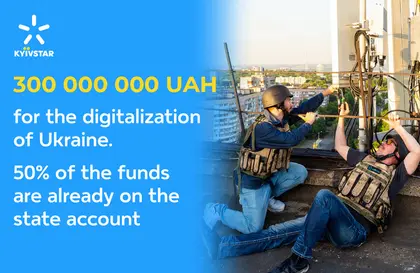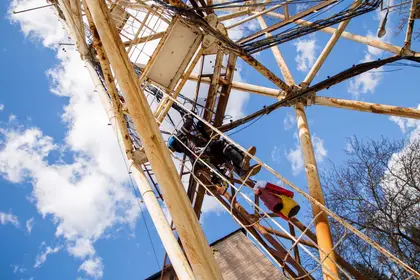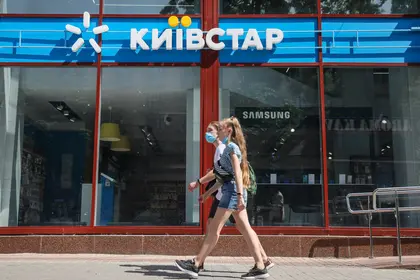Kyivstar Restores 95% of Its Network in Ukrainian Regions Liberated from Occupiers
Up to 30% of telecom equipment in the areas affected by the occupiers—Chernihiv, Sumy, and Kyiv Regions—were unusable after they were liberated by Ukrainian soldiers. Some settlements were left without any communication means at all. Coming back to a peaceful life is closely linked to restoring communication. As wartime events show, communication is as integral a humanitarian need as water, food, and safety.
JOIN US ON TELEGRAM
Follow our coverage of the war on the @Kyivpost_official.
Opening shops, restoring electricity and water supply, and normalizing the local administrative infrastructure are the usual attributes of a peaceful life, just like restoring mobile communications and the Internet.
After liberating many regions from the horrors of the Russian occupation, the communications infrastructure turned out to be practically destroyed there: the occupiers deliberately destroyed and targeted the base stations of mobile operators, bombed local ISP networks, and even stole telecom equipment.

Along with the Ukrainian troops, telecom engineers began the restoration work in the liberated Ukrainian regions. During the occupation, they kept the communications system going, endangering their lives and coming under shelling.
The scale of the destruction is still under assessment, as peace has not come to every part of Ukraine. However, it is extremely impressive in some of the liberated Ukrainian territories. According to the largest Ukrainian mobile operator Kyivstar, which is doing its best to provide communication for 26 million subscribers during wartime, it had to restore the operation of 2,500 base stations and eliminate 48,000 accidents over more than two months of the war. The company replaced 25,000 kilometers of damaged cables. This distance is about 25 times the distance from the eastern-most metropolis of Ukraine, Kharkiv, to the country’s “western capital” of Lviv.

Kyivstar Allocates Hr 300 Million to State for Restoring Infrastructure: 50% Already on State Account
Almost all of Kyivstar’s base stations work thanks to the dedicated efforts of engineers who often endanger their lives under shelling and in mined areas under the cover of the Ukrainian soldiers and volunteers. And that is not it: with no competition in mind, telecom engineers are helping each other to bring communication back to peaceful regions and keep it going where it is still dangerous.
Sumy Region: Engineers of Telecom Companies Jointly Restore Networks
Trostianets, Okhtyrka, and the surrounding villages suffered the most damage in the region, as they saw destroyed buildings, power grids, and other infrastructure, including mobile base stations. The occupiers left “reminders”, such as mines and tripwires, all over the place.
“Our engineers are starting the restoration work as soon as they receive approval from the sappers,” Oleksandr Zhydchenko, Head of Kyivstar’s Network Development Sector, said about the recovery after the occupation and hostilities. “In the Sumy region, the vast majority of settlements have mobile communications. During the hostilities in the region, 47 base stations owned by Kyivstar were damaged, but we have already resumed operation of almost all of them. Some areas still suffer from no electricity supply, so Kyivstar engineers bring generators to power the stations and communications infrastructure. Generators are the real epicenter of civilization here: locals are charging their gadgets. People often offer to refuel our generators to ensure that the communications engineers can continue the restoration work on the next sites.
In the Sumy region, as elsewhere in Ukraine during wartime, engineers of mobile operators and Internet providers help each other set up communication networks as soon as possible.
“During the active hostilities in the region, we had several serious damages to the mainline in several places. If our colleagues had not volunteered to eliminate the accident consequences immediately, the northern part of the Sumy region would have been left without any communication means for a long time. Employees of local ISPs refuel generators that power mobile base stations. For example, Sumy Telecomsystems and the company head, in cooperation with local authorities and organizations during the energy crisis in Sumy, arranged the fuel supply from gas stations to refuel generators of mobile operators. The heads of agricultural companies and forestry help fix the problem in the villages of this region. We contacted them through their families and friends, and they helped us provide power to our base stations,” Oleksandr Zhydchenko said, citing examples of people in the community working together to stay connected.
Kyiv Region: Bombing Base Stations and Grenades in Paper Cups
Kyiv Region saw 229 mobile base stations damaged. Almost 70% of them have already resumed operation. Every day Kyivstar emergency repair teams come to liberated areas to restore communication. Even the smallest of them do not go unnoticed. For example, in the village of Rovy in Vyshhorod District, which is home to a community of 150 people.

Almost all base stations and communication lines were damaged in the settlements affected by the occupiers.
“It seems that our equipment was shot at close range,” Serhii Tchaikov, Chief Engineer for the Central Region at Kyivstar. The largest suburbs of Kyiv, such as Hostomel, Bucha, and Irpin, and the cities of Borodyanka, Ivankiv, and Makariv suffered the most. “The atrocities against civilians are striking,” Serhiy Tchaikov said, citing many examples of occupiers’ meanness. In one of the containers for base stations, the Russian military left paper cups with grenades hidden inside, “Our engineers risk their lives almost everywhere at work,” Serhii Tchaikov commented. “Thanks to the help from the Ukrainian military, rescuers from the State Emergency Service of Ukraine, local administrations, and conscious local residents, telecom engineers can quickly restore communication networks.”
Chernihiv Region: Local Communities Rescue Mobile Base Stations
As a result of bombing and artillery shelling by the Russian occupiers, about 170 base stations were damaged in this region: infrastructure destruction, no power supply, and damage to telecom equipment by Russian troops prevented repair teams from doing their job. After the liberation of this region by the Ukrainian troops, 95% of Kyivstar’s network has now resumed normal operation. Most of the equipment and base stations are still powered by generators because the Chernihiv region has not yet fully restored its energy infrastructure.
Chernihiv faced some of the worst trials during wartime. The city was under siege for a long time and without electricity due to damage to the municipal CHP power plant. Restoration work during active hostilities in the region was associated with difficulties and risks due to artillery shelling and airstrikes. Invaders immediately destroyed the newly repaired stations.
“In such conditions, we formed a list of municipal districts where communication was most critical together with the Armed Forces of Ukraine and the military administration. A team of Kyivstar engineers, who stayed in Chernihiv under shelling all the time, ensured the simultaneous operation of 14 base stations in the besieged city. Powered by generators, they worked around the clock,” Vyacheslav Sakhno, Head of the Technical Maintenance Department, said.
As requested by the Armed Forces of Ukraine, the Territorial Defense Forces of Ukraine, and the military administration, Kyivstar’s specialists created communication channels between facilities that are critical to the city’s military defense.
“Repair work often had to be performed under permanent shelling by the enemy. We thank the soldiers of the Armed Forces of Ukraine who covered us,” Vyacheslav Sakhno recalled.
The Chernihiv region has its examples of how communities stayed connected. In the village of Petrivka (Koryukivskyi district), the occupiers destroyed a base station. But at night, locals collected equipment scattered on the ground and hid it in the basements of their homes.

“After the Ukrainian soldiers liberated the village, our engineers came to restore mobile communications. The head of the village council and the villagers came out to meet them, returning the equipment! Some components were in full working order, so our engineers managed to bring communication back to this community significantly faster,” Vyacheslav Sakhno said.
In another village, Losynivka (Nizhyn District), local residents—at risk for their lives during the occupation—refueled the generator to power Kyivstar’s base station to stay in touch with the outside world and their loved ones.
We know many similar examples where representatives of local communities contacted us and resumed operation of Kyivstar’s stations in their villages, following the advice of our engineers. After all, access to telecommunications is as important a humanitarian need as security, accommodation, medical care, water, and food.
On top of investment in restoring the network, Kyivstar actively supports the economic patriotism announced by the President of Ukraine Volodymyr Zelenskyi. The operator paid almost UAH 1.5 billion in taxes to the country’s budget in advance. The financial assistance to charitable foundations for the needs of military and civilian victims exceeded UAH 30 million.
You can also highlight the text and press Ctrl + Enter







